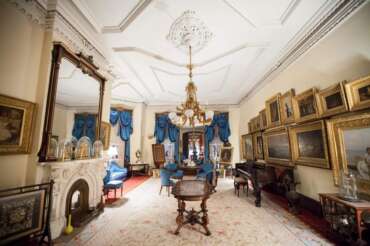
Period Rooms

Entrance Hall
The entrance hall was the most important room in the Victorian home, as it provided the first impression to visitors. The hall stand is the most prominent feature and was an essential piece of furniture during the 19th century. This example is more elaborate than most hall stands of the era. All of the woodwork in the north wing of the house is black walnut. The interior entrance doors have etched glass that have the “R” monogram, which stands for Richardson and an original stained glass transom. The main entrance doors feature a lion head in the center, most likely because Max was born in August and Leo was his zodiac sign. The doors on either side of the entrance are closets. Above are two antelope trophies, which were part of Max’s own collection. He was an avid sportsman, and often traveled to Canada and the American west to hunt.
Another important item in this hall is the calling card table, which is where servants would place the cards of visitors if the family members were away at the time of their visits.
The chandelier is a hybrid of gas and electric. In the early days of electrified homes, it was not necessarily reliable and the family would have had gas to fall back on. The rest of the chandeliers in the main rooms are all original, never electrified and were originally lit by coal gas.

Reception Room
The reception room is where all visitors to the house would have been received. It is also the room where the Richardson family would have spent the majority of their time together. Max was a man of many interests, including art, history, and culture. The artwork in the house was part of his personal collection. The sphinxes at the main entrance reflect his fascination with the ancient cultures, and more specifically the Egyptians. This room is decorated in the Egyptian Revival Style, as seen in the mirror, curtain cornices, and furnishings. The clock on the mantle is also Egyptian in design. The painting on the bottom right next to the fireplace is by Oswego native James Gale Tyler, who became a prominent marine artist of his day. All of his works are seascapes, likely inspired by his childhood in Oswego. The Tyler Art Gallery at Oswego State University is named in his honor.

Drawing Room
The drawing room was the largest and most formal room in the house, and was only used for special occasions. The room was decorated in the Renaissance Revival style by Pottier & Stymus Furniture Company in New York City. This was one of the finest furniture companies in America during the 19th century. They decorated rooms for some of the most famous families of the day. (e.g.: Vanderbilt & Edison) The company decorated the famous Treaty Room in the White House, which is now the President’s private office.
The furniture set was made exclusively for the Richardson family and consists of seven upholstered chairs and settee and four pieces of wood furniture. The mirrors, curtain cornices, and other pieces were also part of the set. The entire room from the carpet to the ceiling would have been designed by this firm. The central table in the middle of the room has an elaborate inlaid top that consists of a variety of 20 different kinds of wood, which creates the detailed pattern. The fireplace mantle in this room is white marble. While fireplaces in the house were functional, this is not the only source of heat as a steam boiler system was added when the second wing was built.
The upholstered furniture and drapery in the Reception and Drawings Rooms were redone in 1976 – paid for by the family members and grants. The carpets were also recreated in 1985.
The piano is a Knabe square grand, and both Naomi and Harriet played piano. The extensive artwork in this room is a collection of both American and European artists and would have reflected the family’s wealth and culture.


Library
The library is part of the south wing addition, which was completed in 1890. The interior of this wing is dramatically different from the north wing. The concepts and tastes in design had changed. The library was an important room in an upper class home, as it reflected education and culture. The atmosphere of this wing is less formal, incorporating the use of various woods and darker colors. The woodwork in this room including the wall paneling, ceiling, and fireplace mantle is made from cherry wood. The craftsmanship in this wing is the work of Oswego cabinetmaker Louis Lavonier, who was a native of France. While paneling was manufactured by machine and the fireplace was purchased separately, Lavonier installed the wood and then hand-carved each of the detailed blocks throughout the room and the decorative detailing on the bookcases. During his time working for the Richardson family, he was paid $1.80 a day.
The bookcases are built into the walls and contain hundreds of volumes that belonged to the Richardson and Bates families. The marble statue is Athena, the Greek goddess of wisdom. She is also the symbol of Union College, the alma mater of Max and Lawrence Richardson, Norman Bates, and Norman Bates Jr.

Dining Room
The dining room is one of the most ornate rooms, with elaborate white oak paneled walls and coffered ceiling. Among the most prominent features is the built-in sideboard with the massive elk trophy displayed above. Built-in furnishings came into fashion during the latter half of the 19th century. This was a trend that eliminated the need for large extravagant pieces of furniture and offered a streamlined approach to design. The elk is one of Max’s prized possessions from his hunting expeditions. Before this room was built, the trophy hung over the main staircase. It is apparent that the sideboard was designed to prominently display the elk. However, it was discovered that the antlers were too large for the space and the ends had to be sawed off in order for it to fit the space.
The two doors on either side of the sideboard are pantries. The one on the left is where the dishes, glassware, silver, and linens were stored. The one on the right was the place where the dishes were removed to after each meal and then washed and dried. There was a small sink in this room and a pass through behind the sideboard. After the dishes were cleaned a servant would pass the clean dishes through to another servant who would put the dishes away. The oriental screen was not only ornamental, but helped camouflage the view and noise of the kitchen. The dining room table is made of cherry wood and has a set of 10 leaves. When fully extended, the table can seat 30 people for dinner. The wallpaper was changed and the patio doors leading to the backyard were added by the Bates family after 1910.

Billiard Room
The first landing of the staircase leads to the mezzanine level of the house. The room to the right is now used as a meeting space, collections processing area and digital lab for the historical society, but originally served as the billiards room for the Richardson family. Billiards was a popular pastime and typically a game enjoyed by men. These were often places where men would retreat after dinner. However, the Richardson family seemed to have been more casual, and the women of the house also enjoyed playing this game with friends and family. Because there is so little left of the original furniture and decor aside from the settee, the faux marble fireplace, wainscot and floor, it can serve as a display space for larger items not relating to the family.
The portraits on the wall are of prominent Oswegonians and the clock is from one of the oldest mansions on the river in the town of Schroeppel.
The door at the back of the room leads to a sleeping porch added in the early 20th century.
Upper Hallway
Also at the mezzanine level directly at the top of the stairs is the elevator shaft door. An elevator was installed by Florence Bates in 1936. It was later removed and sold by the historical society. The upper landing of the hallway features a portrait gallery of the family, from left to right: Harriet Richardson Bates, Max’s sister; Naomi Richardson, Max’s mother; Jacob Richardson, Max’s father (Naomi’s husband); Norman Bates, Max’s nephew; and Jesse Bennett, Max’s maternal grandfather (Naomi’s father).
An outstanding feature of this space is the stained glass skylight. This magnificent skylight was not only decorative, but functional as well. Since this is an interior hallway without windows, the skylight would help lighten the space during the daytime. The armoire is another family piece attributed to Louis Lavonier. Most homes in the 19th century did not have clothes closets. The family would have stored their clothing in dressers or armoires such as this one. The curio cabinet displays the many curiosities and knick-knacks the family purchased during their travels around the country and world. The dollhouse was an early donation to the Oswego County Historical Society from the Kellogg family.

Max’s Bedroom/Temporary Gallery
The first room at the right in the upper hallway was the main bedroom, first of Max Richardson, then of Norman and Florence Bates. It is currently used as the Temporary Gallery, but also has a corner of Max’s furniture, including Japanese inspired fireplace, book case, safe, table and chair. Some of his ethnographic collections are also displayed.
On another wall is the permanent display of Dr. Mary Walker, born in the Town of Oswego: Civil War surgeon, suffragist, dress reformer, second woman in the United States to get a medical degree, and still the only woman ever to be awarded the Medal of Honor.
Naomi’s Bedroom


Naomi Bennett Richardson lived in this house with her three children and grandson until her death in 1890. Naomi was a well-respected matriarch of the Oswego community. Since Max was a bachelor, his mother and sister would have managed the household and societal demands expected of a family of their status. The life of the Richardson family in the late 19th century is largely narrated by Naomi through her diaries and letters she wrote between 1880 and 1890.
Naomi’s bedroom is part of the north wing of the house that was completed by 1872. It is decorated in the Renaissance Revival Style like the rest of the north wing. The elaborate bed and dresser are a set and all of the furnishings in this room are original to the house. The chandelier is also original to this room. Throughout the room you will see the reflection of the Renaissance theme in the chandelier globes, the ceiling medallion, the wall sconces, the curtain cornices, the mirror, and fireplace mantle. The curtains and carpets are reproductions, while the lace panels are the original curtains from this room. The photograph on the west wall of the room is one of Naomi’s mother Harriet Pardee Bennett who died in the 1850’s. The door at the north end of the room led to a shared bathroom with the room next door, which was the bedroom of Naomi’s daughter Harriet Richardson Bates. Harriet’s bedroom now serves as the research library for the historical society. Across from Naomi’s bedroom is a door that leads to the north attic.



